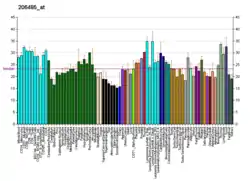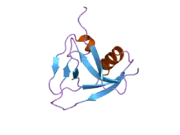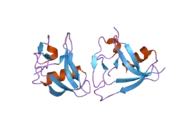CD5 (protein)
CD5[5] is a cluster of differentiation expressed on the surface of T cells (various species) and in a subset of murine B cells known as B-1a. The expression of this receptor in human B cells has been a controversial topic and to date there is no consensus regarding the role of this receptor as a marker of human B cells. B-1 cells have limited diversity of their B-cell receptor due to their lack of the enzyme terminal deoxynucleotidyl transferase (TdT) and are potentially self-reactive. CD5 serves to mitigate activating signals from the BCR so that the B-1 cells can only be activated by very strong stimuli (such as bacterial proteins) and not by normal tissue proteins. CD5 was used as a T-cell marker until monoclonal antibodies against CD3 were developed.
| CD5 | |||||||||||||||||||||||||||||||||||||||||||||||||||
|---|---|---|---|---|---|---|---|---|---|---|---|---|---|---|---|---|---|---|---|---|---|---|---|---|---|---|---|---|---|---|---|---|---|---|---|---|---|---|---|---|---|---|---|---|---|---|---|---|---|---|---|
.jpg.webp) | |||||||||||||||||||||||||||||||||||||||||||||||||||
| |||||||||||||||||||||||||||||||||||||||||||||||||||
| Identifiers | |||||||||||||||||||||||||||||||||||||||||||||||||||
| Aliases | CD5, LEU1, T1, CD5 molecule | ||||||||||||||||||||||||||||||||||||||||||||||||||
| External IDs | OMIM: 153340 MGI: 88340 HomoloGene: 7260 GeneCards: CD5 | ||||||||||||||||||||||||||||||||||||||||||||||||||
| |||||||||||||||||||||||||||||||||||||||||||||||||||
| |||||||||||||||||||||||||||||||||||||||||||||||||||
| |||||||||||||||||||||||||||||||||||||||||||||||||||
| |||||||||||||||||||||||||||||||||||||||||||||||||||
| |||||||||||||||||||||||||||||||||||||||||||||||||||
| Wikidata | |||||||||||||||||||||||||||||||||||||||||||||||||||
| |||||||||||||||||||||||||||||||||||||||||||||||||||
In humans, the gene is located on the long arm of chromosome 11. There is no confirmed ligand for CD5 but there is evidence that CD72, a C-type lectin, may be a ligand or that CD5 may be homophilic, binding CD5 on the surface of other cells.[6] CD5 includes a scavenger receptor cysteine-rich protein domain.
T cells express higher levels of CD5 than B cells. CD5 is upregulated on T cells upon strong activation. In the thymus, there is a correlation with CD5 expression and strength of the interaction of the T cell towards self-peptides.
Immunohistochemistry
CD5 is a good immunohistochemical marker for T-cells, although not as sensitive as CD3. About 76% of T-cell neoplasms are reported to express CD5, and it is also found in chronic lymphocytic leukemia and mantle cell lymphoma (both being B cell malignancies), that do not express CD3. It is commonly lost in cutaneous T-cell lymphoma, and its absence can be used as an indicator of malignancy in this condition. The absence of CD5 in T cell acute lymphoblastic leukemia, while relatively rare, is associated with a poor prognosis.[7]: 67–69
References
- GRCh38: Ensembl release 89: ENSG00000110448 - Ensembl, May 2017
- GRCm38: Ensembl release 89: ENSMUSG00000024669 - Ensembl, May 2017
- "Human PubMed Reference:". National Center for Biotechnology Information, U.S. National Library of Medicine.
- "Mouse PubMed Reference:". National Center for Biotechnology Information, U.S. National Library of Medicine.
- "Entrez Gene: CD5 CD5 molecule".
- Brown, Marion H.; Lacey, Erica (15 November 2010). "A ligand for CD5 is CD5". Journal of Immunology. 185 (10): 6068–74. doi:10.4049/jimmunol.0903823. eISSN 1550-6606. ISSN 0022-1767. LCCN 52052893. OCLC 1778718. PMC 2996635. PMID 20952682.
- Leong, Anthony S-Y; Cooper, Kumarason; Leong, F Joel W-M (1 December 2002). "Section 1 - Antibodies (CD 5)". Manual of Diagnostic Antibodies for Immunohistology (Second ed.). Greenwich Medical Media. pp. 67–69. ISBN 978-1841101002. OCLC 51439459. OL 8917797M. Retrieved 22 December 2022 – via Internet Archive.
Further reading
- Berland R, Wortis HH (2002). "Origins and functions of B-1 cells with notes on the role of CD5". Annu. Rev. Immunol. 20: 253–300. doi:10.1146/annurev.immunol.20.100301.064833. PMID 11861604.
- Osman N, Ley SC, Crumpton MJ (1992). "Evidence for an association between the T cell receptor/CD3 antigen complex and the CD5 antigen in human T lymphocytes". Eur. J. Immunol. 22 (11): 2995–3000. doi:10.1002/eji.1830221135. PMID 1385158. S2CID 34625072.
- Van de Velde H, von Hoegen I, Luo W, Parnes JR, Thielemans K (1991). "The B-cell surface protein CD72/Lyb-2 is the ligand for CD5". Nature. 351 (6328): 662–5. Bibcode:1991Natur.351..662D. doi:10.1038/351662a0. PMID 1711157. S2CID 4342866.
- Jones NH, Clabby ML, Dialynas DP, Huang HJ, Herzenberg LA, Strominger JL (1986). "Isolation of complementary DNA clones encoding the human lymphocyte glycoprotein T1/Leu-1". Nature. 323 (6086): 346–9. Bibcode:1986Natur.323..346J. doi:10.1038/323346a0. PMID 3093892. S2CID 4361866.
- Lankester AC, van Schijndel GM, Cordell JL, van Noesel CJ, van Lier RA (1994). "CD5 is associated with the human B cell antigen receptor complex". Eur. J. Immunol. 24 (4): 812–6. doi:10.1002/eji.1830240406. PMID 7512031. S2CID 25093082.
- Raab M, Yamamoto M, Rudd CE (1994). "The T-cell antigen CD5 acts as a receptor and substrate for the protein-tyrosine kinase p56lck". Mol. Cell. Biol. 14 (5): 2862–70. doi:10.1128/mcb.14.5.2862. PMC 358654. PMID 7513045.
- Dianzani U, Bragardo M, Buonfiglio D, Redoglia V, Funaro A, Portoles P, Rojo J, Malavasi F, Pileri A (1995). "Modulation of CD4 lateral interaction with lymphocyte surface molecules induced by HIV-1 gp120". Eur. J. Immunol. 25 (5): 1306–11. doi:10.1002/eji.1830250526. PMID 7539755. S2CID 37717142.
- Van de Velde H, Thielemans K (1996). "Native soluble CD5 delivers a costimulatory signal to resting human B lymphocytes". Cell. Immunol. 172 (1): 84–91. doi:10.1006/cimm.1996.0218. PMID 8806810.
- Dennehy KM, Broszeit R, Garnett D, Durrheim GA, Spruyt LL, Beyers AD (1997). "Thymocyte activation induces the association of phosphatidylinositol 3-kinase and pp120 with CD5". Eur. J. Immunol. 27 (3): 679–86. doi:10.1002/eji.1830270316. PMID 9079809. S2CID 41540340.
- Gary-Gouy H, Lang V, Sarun S, Boumsell L, Bismuth G (1997). "In vivo association of CD5 with tyrosine-phosphorylated ZAP-70 and p21 phospho-zeta molecules in human CD3+ thymocytes". J. Immunol. 159 (8): 3739–47. doi:10.4049/jimmunol.159.8.3739. PMID 9378960. S2CID 42470132.
- Dennehy KM, Broszeit R, Ferris WF, Beyers AD (1998). "Thymocyte activation induces the association of the proto-oncoprotein c-cbl and ras GTPase-activating protein with CD5". Eur. J. Immunol. 28 (5): 1617–25. doi:10.1002/(SICI)1521-4141(199805)28:05<1617::AID-IMMU1617>3.0.CO;2-7. PMID 9603468.
- Bauch A, Campbell KS, Reth M (1998). "Interaction of the CD5 cytoplasmic domain with the Ca2+/calmodulin-dependent kinase IIdelta". Eur. J. Immunol. 28 (7): 2167–77. doi:10.1002/(SICI)1521-4141(199807)28:07<2167::AID-IMMU2167>3.0.CO;2-L. PMID 9692886.
- Calvo J, Vildà JM, Places L, Simarro M, Padilla O, Andreu D, Campbell KS, Aussel C, Lozano F (1998). "Human CD5 signaling and constitutive phosphorylation of C-terminal serine residues by casein kinase II". J. Immunol. 161 (11): 6022–9. doi:10.4049/jimmunol.161.11.6022. PMID 9834084. S2CID 24141284.
- McAlister MS, Davis B, Pfuhl M, Driscoll PC (1999). "NMR analysis of the N-terminal SRCR domain of human CD5: engineering of a glycoprotein for superior characteristics in NMR experiments". Protein Eng. 11 (10): 847–53. doi:10.1093/protein/11.10.847. PMID 9862202.
- Perez-Villar JJ, Whitney GS, Bowen MA, Hewgill DH, Aruffo AA, Kanner SB (1999). "CD5 negatively regulates the T-cell antigen receptor signal transduction pathway: involvement of SH2-containing phosphotyrosine phosphatase SHP-1". Mol. Cell. Biol. 19 (4): 2903–12. doi:10.1128/mcb.19.4.2903. PMC 84084. PMID 10082557.
- Carmo AM, Castro MA, Arosa FA (1999). "CD2 and CD3 associate independently with CD5 and differentially regulate signaling through CD5 in Jurkat T cells". J. Immunol. 163 (8): 4238–45. doi:10.4049/jimmunol.163.8.4238. PMID 10510361. S2CID 21192459.
- Vilà JM, Calvo J, Places L, Padilla O, Arman M, Gimferrer I, Aussel C, Vives J, Lozano F (2001). "Role of two conserved cytoplasmic threonine residues (T410 and T412) in CD5 signaling". J. Immunol. 166 (1): 396–402. doi:10.4049/jimmunol.166.1.396. PMID 11123317.
- Vilà JM, Gimferrer I, Padilla O, Arman M, Places L, Simarro M, Vives J, Lozano F (2001). "Residues Y429 and Y463 of the human CD5 are targeted by protein tyrosine kinases". Eur. J. Immunol. 31 (4): 1191–8. doi:10.1002/1521-4141(200104)31:4<1191::AID-IMMU1191>3.0.CO;2-H. PMID 11298344.
- Kirchgessner H, Dietrich J, Scherer J, Isomäki P, Korinek V, Hilgert I, Bruyns E, Leo A, Cope AP, Schraven B (2001). "The transmembrane adaptor protein TRIM regulates T cell receptor (TCR) expression and TCR-mediated signaling via an association with the TCR zeta chain". J. Exp. Med. 193 (11): 1269–84. doi:10.1084/jem.193.11.1269. PMC 2193385. PMID 11390434.
- Gary-Gouy H, Harriague J, Dalloul A, Donnadieu E, Bismuth G (2002). "CD5-negative regulation of B cell receptor signaling pathways originates from tyrosine residue Y429 outside an immunoreceptor tyrosine-based inhibitory motif". J. Immunol. 168 (1): 232–9. doi:10.4049/jimmunol.168.1.232. PMID 11751967.
- Mier-Aguilar CA, Vega-Baray B, Burgueño-Bucio E, Lozano F, García-Zepeda EA, Raman C, Soldevila G (2015). "Functional requirement of tyrosine residue 429 within CD5 cytoplasmic domain for regulation of T cell activation and survival". Biochem Biophys Res Commun. 466 (3): 381–7. doi:10.1016/j.bbrc.2015.09.033. PMID 26363459.
External links
- CD5+Antigen at the U.S. National Library of Medicine Medical Subject Headings (MeSH)
- Human CD5 genome location and CD5 gene details page in the UCSC Genome Browser.






